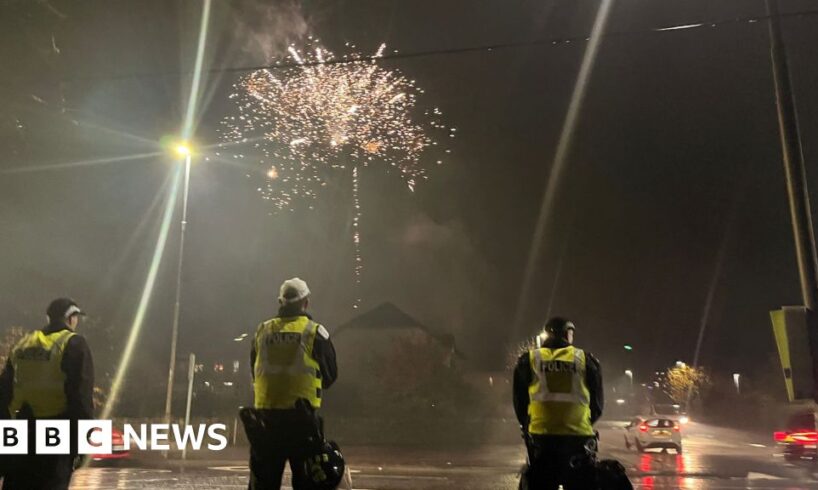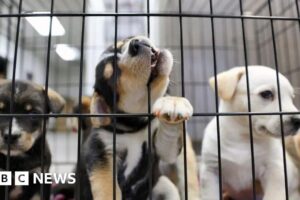
BBC
Police were on patrol in Niddrie where there has been serious Bonfire Night disorder in the past
A major police operation took place at known Bonfire Night trouble spots across Scotland in an attempt to avoid a repeat of disorder seen in previous years.
Firework Control Zones (FCZs) are active some parts of Edinburgh and Glasgow, and officers have been using stop and search powers in both cities as part of Operation Moonbeam.
In West Lothian some bus services were suspended in Blackburn due to antisocial behaviour, but so far there have been no reports of serious disorder.
Police Scotland said it was prepared to enforce “dispersal zones” in certain areas where crowds may gather.
In Glasgow, officers responded to a disturbance on a street close to the Govanhill exclusion zone.
A group of people outside a house party let off a significant number of fireworks, over houses and a nearby school.
A large number of fireworks were let off outside a house in Govanhill but no arrests were made
Two vans full of officers descended on the house but no-one was arrested.
A heavy police presence was also evident in the Niddrie area of Edinburgh, the scene of serious disorder two years ago.
The force helicopter was also deployed over the area, with footage showing small groups of people out on the streets, but not on the scale as in previous years.
Police Scotland
The Police Scotland helicopter was used for reconnaisance work in the Niddrie area of Edinburgh
Earlier the Scottish Fire and Rescue Service (SFRS) warned it would take a “zero-tolerance” approach to disorder when responding to incidents on Bonfire Night.
The SFRS said it expected to receive about 1,000 calls on Wednesday alone.
Though by 22:20, the fire service said it had not received any reports of anti-social behaviour directed at crews.
Earlier Garry Mackay, head of operations, said firefighters should not be put at risk while going about their duties.
Garry Mackay said SFRS crews should not be targeted in the line of duty
Mr Mackay said: “They are fathers, mothers, daughters and sons, they should not be subjected to anything like that at their work,” he added.
“But, on top of that, they are primarily there for public safety and any attack hinders their abilities to do their job and keep communities in Scotland safe.”
Officers have already seized more than a tonne of fireworks which were discovered in a van in Rosyth, Fife, last month.
There have previously been low-level firework attacks on both police and fire crews in Glasgow and Ayrshire since late October.
In one incident a fire engine was taken out of service briefly. Police have also seized varying quantities of fireworks across Scotland including significant hauls during raids in Fife and West Lothian.
Local authorities were granted powers to introduce temporary measures in 2022 after a major riot in Dundee’s Kirkton.
Under the restrictions, it is a criminal offence to set off a firework within the FCZ boundary or throw one into a specific zone.
Organised and licensed fireworks displays are not covered by the rules and sparklers are also allowed to be used privately.
Anyone breaching the restrictions could face up to six months in prison and a fine of up to £5,000.
Dispersal zones give police the power to direct anyone causing, or likely to cause, alarm or distress to leave the area for up to 24 hours.
Failure to comply with those orders may lead to arrest.
They are active in nine zones across Edinburgh until 9 November and three areas of Glasgow – Pollokshields, Govanhill and Broomhouse – until 10 November.
Last year, cars and homes were targeted with fireworks in Pollokshields.
Glasgow City Council had planned to have exclusion areas in place in 2024, however a paperwork deadline was missed meaning the ban could not go ahead.
While they are in force in three areas of the city this year, bids for the control zones were rejected for Woodlands Park, Gartcraig, Crossmyloof, Robroyston, Drumchapel, Ibrox, Yoker and North Kelvin.
Local councillor Jon Molyneux from Pollokshields said that so far the area had been more peaceful than in previous years.
He added: “It’s not stopped people letting off fireworks entirely… but generally it feels like it has been helpful.”
Fireworks and missiles were thrown at police officers in Niddrie, Edinburgh in 2023
In Edinburgh the areas covered by the restrictions include Niddrie, which has been the location of repeated disorder in recent years.
Last year a police officer was injured when the window of a force vehicle was shattered and more than a dozen buses were damaged during an outbreak of violence.
In 2023 about 50 young people clashed with riot police, who were targeted with fireworks and petrol bombs.
Similar scenes of disorder erupted in Sighthill, where rockets were set off near a fuel tanker at a petrol station, and in Southhouse.
Both are also covered by the FCZ.
Other locations include Corstorphine, Moredun, Gracemount and Longstone.
However, concerns have been raised over the way the zones have been drawn up, with some boundaries splitting streets in half.
Firework Control Zones are in place in Edinburgh’s Niddrie
Police Scotland launched Operation Moonbeam earlier this month to tackle crimes involving fireworks across the Bonfire Night period.
This year will mark the first time officers will be equipped with body-worn video cameras as part of a national roll out of the technology.
The Scottish SPCA charity encouraged pet owners to be “mindful” of the “frightening effect” fireworks could have on animals.
Head of advocacy Nicola Strachan suggested dog owners avoid walking them while fireworks were still being let off and that small animals such as rabbits could be kept indoors.
Forvie Nature Reserve in Aberdeenshire has cautioned against letting off fireworks near Newburgh Beach due to the potential impact on two seal pups in the area.
They said an incident last year caused one pup to be abandoned.
RZSS
Roxie the baby red panda was three months old when she died last year
Meanwhile, the Royal Zoological Society of Scotland (RZSS) has reiterated its call for a ban on the public sale of fireworks after the death of one of its red pandas last year.
The zoo is covered by the Corstorphine FCZ this year, but in 2024 “frightening noises” caused by fireworks exploding nearby were cited as the cause of death for three-month-old red panda kit Roxie.
Her mother, Ginger, had died five days earlier, which the zoo could also have been linked to firework stress.
RZSS deputy chief executive Ben Supple said: “While the new exclusion zone is a very positive step, loud and unpredictable fireworks continue to cause real distress for animals and people across Scotland.
“Roxie’s death was a tragic reminder of how dangerous this issue can be.
“We hope everyone will think carefully about the impact of fireworks and support our call for a national ban on their public sale.”





